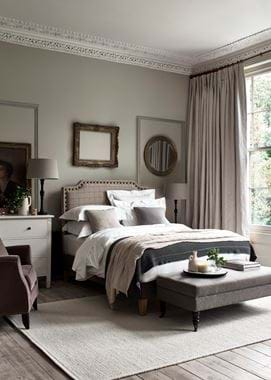Make a focal point of footstools
Make a focal point of footstools
They don’t get as much love as sofas or armchairs, but footstools (or ottomans, if you prefer) can prove their worth in any number of ways – and not just in living rooms. Here’s why every home should have at least one (and probably a few more).
They’re a softer alternative to coffee tables and side tables
The classic arrangement of a sofa and armchairs with a coffee table in between will never go out of style, but substitute an upholstered footstool and the effect is gentler and cosier; somewhere you’ll be more comfortable putting your feet up. There are no hard edges to bump into either, so they’re great if you have children around.
Pick one with a firm, flat top, and you can still use it like a table to display books, flowers, tea trays and even scented candles (as long as there’s a protective surface underneath). Or, if you prefer one with deep cushioning, use a tray to give you a sturdy surface.
Another idea is to replace the side tables that sit beside a sofa with small footstools, such as cube or drum shapes. Because they’re designed to be lightweight and portable, they’re more versatile – designs like our Milo drum stool, with its leather handle, are easily carried to wherever they’re needed. They can be handy at the dining table, for instance, as holding spots for books and magazines – even an extra seat.
When it comes to fabrics, a colour contrast with the rest of your seating will draw the eye, so footstools don’t get lost among bigger pieces of furniture. They’re a great way to add a little pattern to a room without it feeling too heavy, but choose a hard-wearing material like leather or wool for anything you plan to use like a table.
They can add symmetry to a space
Objects arranged in pairs encourage the eye to home in on key features. Try placing two small footstools in front of a pair of statement armchairs to highlight them, or if you have a pair of windows in a room, place one footstool under each and add a cushion or two (it looks best if the footstools are just slightly wider than the windows themselves).
You could also place two footstools together in place of a coffee table: a staggered formation works well, or try layering a tall design crossways over a lower one.
If your room has a strong feature like a fireplace or a set of double doors, framing this with footstools at either side will make it feel a little grander.
They make great hallway seats
In a compact space like a hallway, it’s easier for a footstool to be the centre of attention, as there are fewer pieces of furniture to compete with. A narrow, bench-style design like our Rupert footstool is perfect here – it has a little extra height, so you can keep shoes and bags underneath.
A simple shape like this also works well with mirrors or artworks hung above and around it, while its softness will make people feel welcome from the moment they step indoors.
They look elegant at the end of the bed
Apart from being useful for dressing, a footstool at the end of the bed somehow just makes a bedroom feel more polished. You can also use it for stacking extra bed throws and cushions.
To make a feature of it, choose a plush velvet in a rich colour or a classic leather – something that catches the eye, but won’t compete with other textiles in the room, like bed linen.
They make a bathroom feel more pampering
There’s a big trend for soft furnishings moving into the bathroom, where they add a welcome note of comfort among all the hard surfaces.
If you don’t have space for an armchair, a footstool is just as good, whether for post-bath relaxation or to hold a tray with candles and bath oils.
In this setting, your choice of fabric may be shaped by practicality – tweeds and are less vulnerable to water splashes than leather.
Footstools are also a good way to display towels, especially in small guest bathrooms, where their neat proportions feel just right.
Explore our footstool collection.














